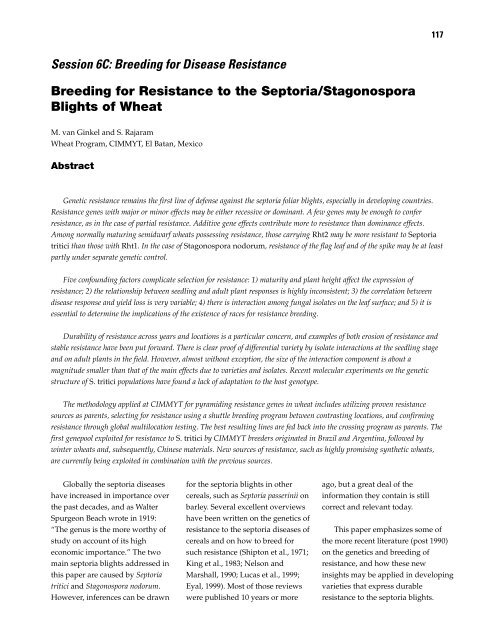Septoria and Stagonospora Diseases of Cereals - CIMMYT ...
Septoria and Stagonospora Diseases of Cereals - CIMMYT ...
Septoria and Stagonospora Diseases of Cereals - CIMMYT ...
You also want an ePaper? Increase the reach of your titles
YUMPU automatically turns print PDFs into web optimized ePapers that Google loves.
Session 6C: Breeding for Disease Resistance<br />
Breeding for Resistance to the <strong>Septoria</strong>/<strong>Stagonospora</strong><br />
Blights <strong>of</strong> Wheat<br />
M. van Ginkel <strong>and</strong> S. Rajaram<br />
Wheat Program, <strong>CIMMYT</strong>, El Batan, Mexico<br />
Abstract<br />
Genetic resistance remains the first line <strong>of</strong> defense against the septoria foliar blights, especially in developing countries.<br />
Resistance genes with major or minor effects may be either recessive or dominant. A few genes may be enough to confer<br />
resistance, as in the case <strong>of</strong> partial resistance. Additive gene effects contribute more to resistance than dominance effects.<br />
Among normally maturing semidwarf wheats possessing resistance, those carrying Rht2 may be more resistant to <strong>Septoria</strong><br />
tritici than those with Rht1. In the case <strong>of</strong> <strong>Stagonospora</strong> nodorum, resistance <strong>of</strong> the flag leaf <strong>and</strong> <strong>of</strong> the spike may be at least<br />
partly under separate genetic control.<br />
Five confounding factors complicate selection for resistance: 1) maturity <strong>and</strong> plant height affect the expression <strong>of</strong><br />
resistance; 2) the relationship between seedling <strong>and</strong> adult plant responses is highly inconsistent; 3) the correlation between<br />
disease response <strong>and</strong> yield loss is very variable; 4) there is interaction among fungal isolates on the leaf surface; <strong>and</strong> 5) it is<br />
essential to determine the implications <strong>of</strong> the existence <strong>of</strong> races for resistance breeding.<br />
Durability <strong>of</strong> resistance across years <strong>and</strong> locations is a particular concern, <strong>and</strong> examples <strong>of</strong> both erosion <strong>of</strong> resistance <strong>and</strong><br />
stable resistance have been put forward. There is clear pro<strong>of</strong> <strong>of</strong> differential variety by isolate interactions at the seedling stage<br />
<strong>and</strong> on adult plants in the field. However, almost without exception, the size <strong>of</strong> the interaction component is about a<br />
magnitude smaller than that <strong>of</strong> the main effects due to varieties <strong>and</strong> isolates. Recent molecular experiments on the genetic<br />
structure <strong>of</strong> S. tritici populations have found a lack <strong>of</strong> adaptation to the host genotype.<br />
The methodology applied at <strong>CIMMYT</strong> for pyramiding resistance genes in wheat includes utilizing proven resistance<br />
sources as parents, selecting for resistance using a shuttle breeding program between contrasting locations, <strong>and</strong> confirming<br />
resistance through global multilocation testing. The best resulting lines are fed back into the crossing program as parents. The<br />
first genepool exploited for resistance to S. tritici by <strong>CIMMYT</strong> breeders originated in Brazil <strong>and</strong> Argentina, followed by<br />
winter wheats <strong>and</strong>, subsequently, Chinese materials. New sources <strong>of</strong> resistance, such as highly promising synthetic wheats,<br />
are currently being exploited in combination with the previous sources.<br />
Globally the septoria diseases<br />
have increased in importance over<br />
the past decades, <strong>and</strong> as Walter<br />
Spurgeon Beach wrote in 1919:<br />
“The genus is the more worthy <strong>of</strong><br />
study on account <strong>of</strong> its high<br />
economic importance.” The two<br />
main septoria blights addressed in<br />
this paper are caused by <strong>Septoria</strong><br />
tritici <strong>and</strong> <strong>Stagonospora</strong> nodorum.<br />
However, inferences can be drawn<br />
for the septoria blights in other<br />
cereals, such as <strong>Septoria</strong> passerinii on<br />
barley. Several excellent overviews<br />
have been written on the genetics <strong>of</strong><br />
resistance to the septoria diseases <strong>of</strong><br />
cereals <strong>and</strong> on how to breed for<br />
such resistance (Shipton et al., 1971;<br />
King et al., 1983; Nelson <strong>and</strong><br />
Marshall, 1990; Lucas et al., 1999;<br />
Eyal, 1999). Most <strong>of</strong> those reviews<br />
were published 10 years or more<br />
ago, but a great deal <strong>of</strong> the<br />
information they contain is still<br />
correct <strong>and</strong> relevant today.<br />
117<br />
This paper emphasizes some <strong>of</strong><br />
the more recent literature (post 1990)<br />
on the genetics <strong>and</strong> breeding <strong>of</strong><br />
resistance, <strong>and</strong> how these new<br />
insights may be applied in developing<br />
varieties that express durable<br />
resistance to the septoria blights.









